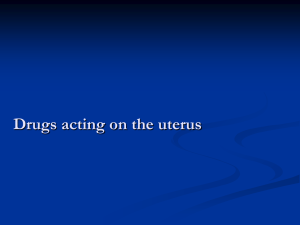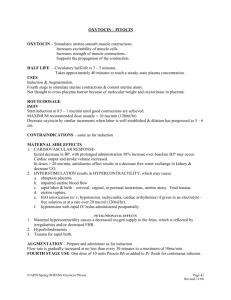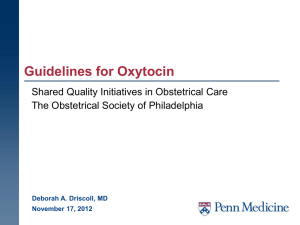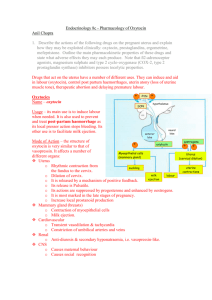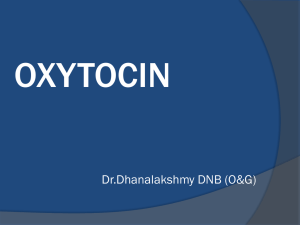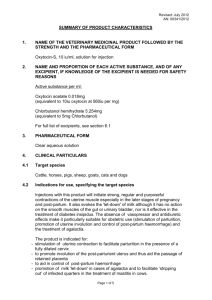Oxytocin Injection BP
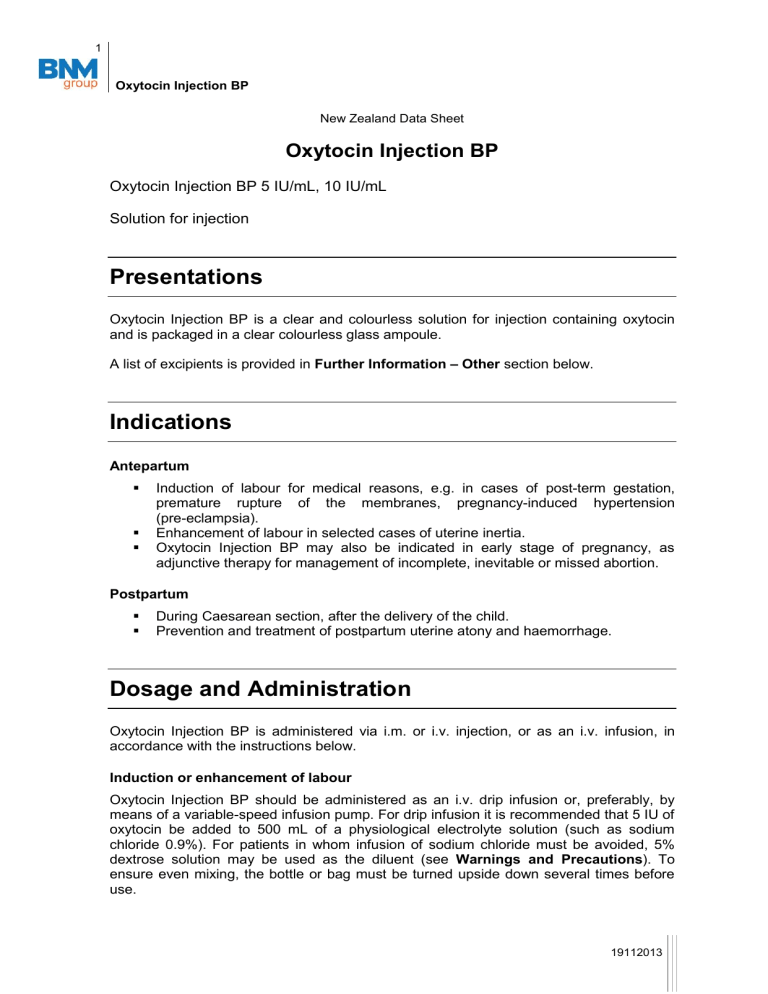
1
Oxytocin Injection BP
New Zealand Data Sheet
Oxytocin Injection BP
Oxytocin Injection BP 5 IU/mL, 10 IU/mL
Solution for injection
Presentations
Oxytocin Injection BP is a clear and colourless solution for injection containing oxytocin and is packaged in a clear colourless glass ampoule.
A list of excipients is provided in Further Information – Other section below.
Indications
Antepartum
Induction of labour for medical reasons, e.g. in cases of post-term gestation, premature rupture of the membranes, pregnancy-induced hypertension
(pre-eclampsia).
Enhancement of labour in selected cases of uterine inertia.
Oxytocin Injection BP may also be indicated in early stage of pregnancy, as adjunctive therapy for management of incomplete, inevitable or missed abortion.
Postpartum
During Caesarean section, after the delivery of the child.
Prevention and treatment of postpartum uterine atony and haemorrhage.
Dosage and Administration
Oxytocin Injection BP is administered via i.m. or i.v. injection, or as an i.v. infusion, in accordance with the instructions below.
Induction or enhancement of labour
Oxytocin Injection BP should be administered as an i.v. drip infusion or, preferably, by means of a variable-speed infusion pump. For drip infusion it is recommended that 5 IU of oxytocin be added to 500 mL of a physiological electrolyte solution (such as sodium chloride 0.9%). For patients in whom infusion of sodium chloride must be avoided, 5% dextrose solution may be used as the diluent (see Warnings and Precautions ). To ensure even mixing, the bottle or bag must be turned upside down several times before use.
19112013
2
Oxytocin Injection BP
The initial infusion rate should be set at 1 to 4 milliunits/minute (2 to 8 drops/minute). It may be increased gradually at intervals not shorter than 20 minutes until a contraction pattern similar to that of normal labour is established. In pregnancy near term, this can often be achieved with an infusion of less than 10 milliunits/minute (20 drops/minute), and the recommended maximum rate is 20 milliunits/minute (40 drops/minute). In the unusual event of higher rates being required, as may occur in the management of foetal death in utero or for induction of labour at an earlier stage of pregnancy when the uterus is less sensitive to oxytocin, it is advisable to use a more concentrated Oxytocin Injection BP solution, e.g. 10 IU in 500 mL.
When using a motor-driven infusion pump which delivers smaller volumes than those given by drip infusion, the concentration suitable for infusion within the recommended dosage range must be calculated according to the specifications of the pump.
The frequency, strength and duration of contractions and also the foetal heart rate must be carefully monitored throughout the infusion. Once an adequate level of uterine activity is attained, the infusion rate can often be reduced. In the event of uterine hyperactivity and/or foetal distress, the infusion must be discontinued immediately.
If, in women who are at term or near term, regular contractions are not established after the infusion of a total amount of 5 IU, it is recommended that the attempt to induce labour should be terminated; it may be repeated on the following day, starting again from a rate of 1 to 4 milliunits/minute.
Note
Inadvertent paravenous infusion of oxytocin is not harmful.
Caesarean section
5 IU by i.v. infusion (5 IU diluted in physiological electrolyte solution and administered as an i.v. drip infusion or, preferably, by means of a variable-speed infusion pump over
5 minutes) immediately after delivery.
Prevention of postpartum uterine haemorrhage
The usual dose is 5 IU by i.v. infusion (5 IU diluted in physiological electrolyte solution and administered as an i.v. drip infusion or, preferably, by means of a variable-speed infusion pump over 5 minutes) or 5 to 10 IU i.m. after delivery of the placenta.
In women given Oxytocin Injection BP for induction or enhancement of labour, the infusion should be continued at an increased rate during the third stage of labour and for the next few hours thereafter.
Treatment of postpartum uterine haemorrhage
5 IU by i.v. infusion (5 IU diluted in physiological electrolyte solution and administered as an i.v. drip infusion or, preferably, by means of a variable-speed infusion pump over
5 minutes), or 5 to 10 IU i.m., followed in severe cases by intravenous infusion of a solution containing 5 to 20 IU of oxytocin in 500 mL of an electrolyte-containing diluent, run at the rate necessary to control uterine atony.
Incomplete, inevitable, or missed abortion
5 IU by i.v. infusion (5 IU diluted in physiological electrolyte solution and administered as an i.v. drip infusion or, preferably, by means of a variable-speed infusion pump over
19112013
3
Oxytocin Injection BP
5 minutes) or 5 to 10 IU i.m., if necessary followed by i.v. infusion at a rate of 20 to
40 milliunits/minute or higher.
Contraindications
Known hypersensitivity to oxytocin or to any of the excipients of Oxytocin Injection BP.
Hypertonic uterine contractions, foetal distress when delivery is not imminent.
Any condition in which, for foetal or maternal reasons, spontaneous labour is inadvisable and/or vaginal delivery is contraindicated: e.g. significant cephalopelvic disproportion, foetal malpresentation (e.g. breech presentation); placenta praevia and vasa praevia, placental abruption, umbilical cord entanglement or prolapse; overdistension or impaired resistance of the uterus to rupture as in multiple pregnancy, polyhydramnios, grand multiparity and in the presence of a uterine scar resulting from major surgery including classical Caesarean section.
Any of the following conditions:
Tendency of the uterus to pass into tetanic contractions (sustained uterine contractions);
Immature cervix;
Imminent foetal asphyxia (acute, severe oxygen deficiency in the newborn following inadequate oxygen intake);
Uterine hyperactivity (increased) should be avoided in the event of foetal death in utero and in the presence of meconium-stained amniotic fluid given the risk of amniotic fluid embolism.
Warnings and Precautions
The induction of labour by means of oxytocin should be attempted only when strictly indicated for medical reasons, rather than for convenience. Administration should only be under hospital conditions and qualified medical supervision.
Oxytocin Injection BP should not be used for prolonged periods in patients with oxytocinresistant uterine inertia, severe pre-eclamptic toxaemia or severe cardiovascular disorders.
Oxytocin Injection BP should not be given as i.v. bolus injection as it may cause an acute short-lasting hypotension accompanied with flushing and reflex tachycardia.
Oxytocin Injection BP should be used with caution in patients who have a pre-disposition to myocardial ischemia due to pre-existing cardiovascular disease (such as hypertrophic cardiomyopathy, valvular heart disease and/or ischemic heart disease including coronary artery vasospasm), to avoid significant changes in blood pressure and heart rate in these patients.
Oxytocin Injection BP should be given with caution to patients with known ‘long QT syndrome’ or related symptoms, and to patients taking medicines that are known to prolong the QTc interval.
19112013
4
Oxytocin Injection BP
When Oxytocin Injection BP is given for induction and enhancement of labour:
It must only be administered as an i.v. infusion, and never by s.c., i.m. or i.v. bolus injection.
Administration of oxytocin at excessive doses results in uterine overstimulation which may cause foetal distress, asphyxia and death, or may lead to hypertonicity, tetanic contractions or rupture of the uterus. Careful monitoring of foetal heart rate and uterine motility (frequency, strength, and duration of contractions) is essential, so that the dosage may be adjusted to individual response.
Particular caution is required in the presence of borderline cephalopelvic disproportion, secondary uterine inertia, mild or moderate degrees of pregnancyinduced hypertension or cardiac disease and in patients above 35 years of age or with a history of lower-uterine-segment caesarean section.
In rare circumstances, the pharmacological induction of labour using uterotonic agents including oxytocin increases the risk of postpartum disseminated intravascular coagulation (DIC). The pharmacological induction itself and not a particular agent is linked to such risk. This risk is increased in particular if the woman has additional risk factors for DIC such as being 35 years of age or over, complications during the pregnancy and gestational age more than 40 weeks. In these women, oxytocin or any other alternative medicine should be used with care, and the practitioner should be alerted by signs of DIC.
In the case of foetal death in utero , and/or in the presence of meconium-stained amniotic fluid, tumultuous labour must be avoided, as it may cause amniotic fluid embolism.
Because oxytocin possesses slight antidiuretic activity, its prolonged i.v. administration at high doses in conjunction with large volumes of fluid, as may be the case in the treatment of inevitable or missed abortion, or in the management of postpartum haemorrhage, may cause water intoxication associated with hyponatraemia. The combined antidiuretic effect of oxytocin and the i.v. fluid administration may cause fluid overload leading to a haemodynamic form of acute pulmonary oedema without hyponatraemia.
To avoid these rare complications, the following precautions must be observed whenever high doses of oxytocin are administered over a long time:
an electrolyte-containing diluent must be used (not dextrose);
the volume of infused fluid should be kept low (by infusing oxytocin at a higher concentration than recommended for the induction or enhancement of labour at term);
fluid intake by mouth must be restricted;
a fluid balance chart should be kept and serum electrolytes should be measured when electrolyte imbalance is suspected.
The limit of 16 milliunits/minute should only be briefly exceeded as the possibility of hyperbilirubinaemia (excess serum levels of bilirubin) in the child cannot be ruled out with any certainty following long-term administration of high dose levels. Furthermore, retinal haemorrhage has been reported in newborn infants following hyperactive uterine activity.
Use in pregnancy
Animal reproduction studies have not been conducted with oxytocin. Based on the wide experience with this medicine and its chemical structure and pharmacological properties, it is not expected to present a risk of foetal abnormalities when used as indicated.
19112013
5
Oxytocin Injection BP
Use in lactation
Oxytocin may be found in small quantities in mother’s breast milk. However, oxytocin is not expected to cause harmful effects in the newborn because it passes into the alimentary tract where it undergoes rapid inactivation.
Effects on ability to drive and use machines:
Oxytocin Injection BP can induce labour, therefore caution should be exercised when driving or operating machines. Women with uterine contractions should not drive or use machines.
Other
Preclinical safety data:
Pre-clinical data for oxytocin reveal no special hazard for humans based on conventional studies of single dose acute toxicity, genotoxicity, and mutagenicity.
Effects (foetal loss in rats) in one pre-clinical study were observed only at exposures considered sufficiently in excess of the maximum human exposure indicating little relevance to clinical use.
Acute toxicity:
Single dose toxicity studies with oxytocin in rats and mice have been conducted by the oral, intravenous and subcutaneous application routes. Acute oral (and subcutaneous) toxicity was 20.5 mg/kg bodyweight in rats and exceeded 514 mg/kg bodyweight in mice.
By the intravenous route, the lethal oxytocin dose amounted to 2.3 mg/kg bodyweight in rats and to 5.8 mg/kg bodyweight in mice. Thus, the intravenous lethal oxytocin dose in mice exceeds the usual intravenous dose in humans by a factor of greater than one thousand.
Mutagenicity:
An in vitro genotoxicity and mutagenicity study with oxytocin has been reported. Tests were negative for chromosomal aberration and sister chromatid exchange in human peripheral lymphocyte cultures. No significant changes in the mitotic index were noticed.
Oxytocin had no genotoxic properties.
Carcinogenicity, teratogenicity and reproduction toxicity:
Treatment of rats with oxytocin early in pregnancy in doses thousands of times greater than the dose used to induce labour in humans caused foetal loss in one study, but its relevance is unknown. No standard teratogenicity, reproductive performance and carcinogenicity studies with oxytocin are available.
Adverse Effects
When oxytocin is used by i.v. infusion for the induction or enhancement of labour, its administration at excessive doses results in uterine overstimulation, which may cause foetal distress, asphyxia and death, or may lead to hypertonicity, tetanic contractions or rupture of the uterus.
19112013
6
Oxytocin Injection BP
Water intoxication associated with maternal and neonatal hyponatraemia has been reported in cases where high doses of oxytocin have been administered together with large amounts of electrolyte-free fluid over a prolonged period of time (see Warnings and
Precautions ).
The combined antidiuretic effect of oxytocin and the i.v. fluid administration may cause fluid overload leading to a haemodynamic form of acute pulmonary oedema without hyponatraemia (see Warnings and Precautions ).
Rapid i.v. bolus injection of oxytocin at doses amounting to several IU may result in acute short-lasting hypotension accompanied with flushing and reflex tachycardia (see
Warnings and Precautions ). These rapid haemodynamic changes may result in myocardial ischemia, particularly in patients with pre-existing cardiovascular disease.
Rapid i.v. bolus injection of oxytocin at doses amounting to several IU may also lead to
QTc prolongation.
In rare circumstances (i.e. incidence rate < 0.0006), the pharmacological induction of labour using uterotonic agents, including oxytocin, increases the risk of postpartum disseminated intravascular coagulation (see Warnings and Precautions ).
With either mode of administration, oxytocin may cause the following adverse effects:
Adverse reactions (Table 1) are ranked under heading of frequency, the most frequent first, using the following convention: very common (≥ 1/10); common (≥ 1/100, < 1/10); uncommon (≥ 1/1,000, < 1/100); rare (≥ 1/10,000, < 1/1,000) very rare (< 1/10,000), including isolated reports.
Table 1 Adverse reactions of oxytocin
Immune system disorders
Uncommon:
Allergic reactions (which may lead to anaphylactic shock)
Nervous system disorders
Common:
Cardiac disorders
Common:
Headache (especially at high doses)
Tachycardia, bradycardia, arrhythmia (at high doses)
Gastrointestinal disorders
Common: Nausea, vomiting (especially at high doses)
Skin and subcutaneous tissue disorders
Rare: Rash
Blood and lymphatic system disorders
Rare: Disseminated intravasal coagulation
19112013
7
Oxytocin Injection BP
Vascular disorders
Common:
Frequency not known
Hypertension
Marked fall in blood pressure following rapid intravenous injection (during the postpartum period)
Pregnancy, post-partum and perinatal disorders
Very common:
Uncommon:
Excessive uterine activity
Tetanic contractions (sustained uterine contractions) with excessive uterine activity leading to hypoxia (lack of oxygen) in the newborn
Renal and urinary disorders
Very rare:
Decreased urination, water intoxication with reduced blood serum sodium levels (hyponatraemia) in the mother and the child (especially with i.v. infusion). These can lead to cerebral oedema, seizures and coma.
These symptoms occur mainly when oxytocin is administered intravenously at very high dose levels with a large fluid intake for a prolonged period. Hyponatraemia can be avoided if an electrolyte solution is used for infusion.
Interactions
Prostaglandins can potentiate the effect of oxytocin as they can lead to sensitisation of the myometrium (layer of muscle in uterine wall) to oxytocin. Since this synergistic effect is unpredictable and cannot be controlled, the concomitant administration of oxytocin and prostaglandins should be avoided. It is recommended that an interval of at least six hours be allowed between prostaglandin administration and subsequent oxytocin administration.
Some inhalation anaesthetics, e.g. cyclopropane or halothane, may enhance the hypotensive effect of oxytocin and reduce its oxytocic action. Their concurrent use with oxytocin has also been reported to cause cardiac rhythm disturbances.
Oxytocin should be given with caution in patients taking medicines that are known to prolong the QTc interval.
When given during or after caudal block anaesthesia, oxytocin may potentiate the pressor effect of sympathomimetic vasoconstrictor agents.
The uterus-contracting effect of oxytocin is potentiated by methylergometrin.
When taken simultaneously, sympathomimetic medicines that increase blood pressure and oxytocin can cause prolonged arterial hypertension (extended rise of blood pressure).
19112013
8
Oxytocin Injection BP
Patients receiving antihypertensive medication should be closely monitored as the effect of this substance can be enhanced during oxytocin administration.
Overdose
The symptoms and consequences of overdose are those mentioned under Warnings and Precautions and Adverse Effects above. In addition, placental abruption and/or amniotic fluid embolism as a result of uterine overstimulation have been reported.
Treatment
When signs or symptoms of overdose occur during continuous i.v. administration of
Oxytocin Injection BP, the infusion must be discontinued at once and oxygen should be given to the mother. In the event of water intoxication, it is essential to restrict fluid intake, promote dieresis, correct electrolyte imbalance; and control possible convulsions by judicious use of diazepam.
Further Information
Actions
Pharmacotherapeutic group: Posterior pituitary lobe hormones
ATC code H01B B02 Oxytocin
The active substance of Oxytocin Injection BP is a synthetic nonapeptide identical to oxytocin, a hormone released by the posterior lobe of the pituitary. It exerts a stimulatory effect on the uterine smooth muscle, particularly towards the end of pregnancy, during labour, after delivery and in the puerperium, i.e. at times when the number of specific oxytocin receptors in the myometrium is increased.
When given by low-dose i.v. infusion, Oxytocin Injection BP elicits rhythmic uterine contractions that are indistinguishable in frequency, force and duration from those observed during spontaneous labour. At higher infusion dosages, or when given by single injection, the medicine is capable of causing sustained tetanic uterine contractions.
In addition to its effects on the uterus, oxytocin contracts the myoepithelial cells surrounding the mammary alveoli, thereby causing milk ejection and facilitating breastfeeding.
Being synthetic, Oxytocin Injection BP does not contain vasopressin, but even in its pure form oxytocin possesses some weak intrinsic vasopressin-like antidiuretic activity.
Another pharmacological effect observed with high doses of oxytocin, particularly when administered by rapid i.v. bolus injection, is a transient direct relaxing effect on vascular smooth muscle, resulting in brief hypotension, flushing and reflex tachycardia (see
Warnings and Precautions ).
19112013
9
Oxytocin Injection BP
Pharmacokinetics
Absorption
Intravenous infusion.
When Oxytocin Injection BP is given by continuous i.v. infusion at doses appropriate for induction or enhancement of labour, the uterine response sets in gradually and usually reaches a steady state within 20 to 40 minutes. The corresponding plasma levels of oxytocin are comparable to those measured during spontaneous firststage labour. For example, oxytocin plasma levels in 10 pregnant women at term receiving a 4 milliunits per minute intravenous infusion were 2 to 5 microunits/mL. Upon discontinuation of the infusion, or following a substantial reduction in the infusion rate, e.g. in the event of overstimulation, uterine activity declines rapidly but may continue at an adequate lower level.
Intravenous injection and intramuscular injection .
When administered by i.v. or i.m. injection for prevention or treatment of postpartum haemorrhage, Oxytocin Injection BP acts rapidly with a latency period of less than 1 minute by i.v. injection, and of 2 to 4 minutes by i.m. injection. The oxytocic response lasts for 30 to 60 minutes after i.m. administration, possibly less after i.v. injection.
Oxytocin is not active orally.
Distribution
Oxytocin distributes throughout the extracellular fluid, with minimal amounts reaching the foetus. The steady-state distribution volume determined in 6 healthy men after intravenous injection was 12.2 L or 0.17 L/kg. Plasma protein binding is very low.
Oxy tocin may be found in small quantities in mother’s breast milk.
Metabolism
A glycoprotein aminopeptidase, oxytocinase, is produced during pregnancy and appears in the plasma. It is capable of degrading oxytocin. Enzyme activity increases gradually until term approaches, at which time it rises steeply to high levels. Enzyme activity then declines after delivery. Enzyme activity in the placenta and in the uterine tissue is also high during this period. There is little or no degradation of oxytocin by plasma from men, non-pregnant women, or cord blood.
Elimination
The relative ease with which the rate and force of uterine contractions can be regulated by the i.v. infusion of Oxytocin Injection BP is due to the short half-life of oxytocin. Values reported by various investigators range from 3 to 20 minutes. Removal of oxytocin from plasma is accomplished mainly by the liver and the kidneys. The metabolic clearance rate amounts to about 20 mL/kg per minute in men as well as in pregnant women. Less than
1% of a given dose is excreted unchanged in the urine.
19112013
10
Oxytocin Injection BP
Other
Chemical structure:
Molecular formula: C
43
H
66
N
12
O
12
S
2
Relative molecular mass: 1007.19
CAS number: 50-56-6
Oxytocin is L-Cysteinyl-L-tyrosyl-L-isoleucyl-L-glutamyl-L-asparaginyl-L-cysteinyl-L-prolyl-
Lleucylglycinamide cyclic (1→6)-disulfide. It occurs as white or almost white hygroscopic powder. It is very soluble in water. It dissolves in dilute solutions of acetic acid and of ethanol (96%).
Active ingredient
Oxytocin
Inactive ingredients
Sodium chloride
Acetic acid, glacial
Sodium acetate
Water for injections
Oxytocin Injection BP contains sodium but less than 1 mmol (23 mg) sodium per ampoule.
19112013
11
Oxytocin Injection BP
Pharmaceutical Precautions
Instructions for handling
Any unused product or waste material should be disposed of in accordance with local requirements.
Incompatibilities
In the absence of compatibility studies, Oxytocin Injection BP must not be mixed with other medicinal products.
Shelf-life
The shelf life of Oxytocin Injection BP is 36 months from date of manufacture.
From a microbiological point of view, the ready-to-use preparation should be used immediately or stored at 2 - 8°C for not more than 24 hours. If not used immediately, inuse storage times and conditions prior to use are the responsibility of the user.
Special precautions for storage
Store Oxytocin Injection BP between 2°C and 8°C.
Oxytocin Injection BP can be stored temporarily at 25°C (e.g. in the delivery room) for 6 months. After this time Oxytocin Injection BP must be discarded and not returned to the refrigerator.
Package Quantities
Oxytocin Injection BP 5 IU/mL solution for injection
1 mL ampoule contains 5 IU oxytocin
(equivalent to 8.3 mcg/mL)
5 x 1 mL clear glass ampoules per pack
Oxytocin Injection BP 10 IU/mL solution for injection
1 mL ampoule contains 10 IU oxytocin
(equivalent to 16.6 mcg/mL)
5 x 1 mL clear glass ampoules per pack
Medicine Schedule
Prescription Medicine
19112013
12
Oxytocin Injection BP
Sponsor Details
BNM Group
39 Anzac Road
Browns Bay
Auckland 0753
Ph: 0800 565 633
Date of Preparation
19 November 2013
19112013

